TORTRICIDAE - Cydia
Taxonomy
Tortricoidea: Tortricidae: Olethreutinae: Grapholitini: Cydia
Synonyms: Carpocapsa, Laspeyresia, Melissopus, many others
Larval diagnosis (Summary)
- D1 and SD1 on the same pinaculum on A9
- L group on T1 does not extend beneath the spiracle
- Anal comb absent
- Borers in fruit, nuts, cones, and pods
Host/origin information
Because Cydia is a cosmopolitan genus, larvae can originate from most any country or continent. The following are the most frequent origin/host combinations:
| Origin |
Host(s) |
| Asia | Castanea |
| Europe | Castanea |
| Armenia | Malus, Prunus |
| Brazil | Araucaria |
| Mexico | Cydonia, Malus, Prunus, Pyrus, Quercus |
Recorded distribution
Cydia is a worldwide genus that is found on every continent except Antarctica.
Identification authority (Summary)
Identifications of Cydia should be restricted to internal-feeding tortricid larvae that possess all three of the following characters:
D1 and SD1 on the same pinaculum on A9; L group on T1 not extending beneath the spiracle; and anal comb absent. Larvae in other genera may
have similar morphology; see the Detailed Information tab for further discussion.
Pest characterization
(Based on Cavey 2001, Gilligan and Epstein 2012)
- Taxonomy: High. Identification to genus is usually possible.
- Distribution: High/Low. Some Cydia are present in the U.S.; however, some important pest species are not.
- Potential Impact: High. Many Cydia are important pests.
This ranking characterizes Cydia as quarantine significant for the U.S. in some instances and not quarantine significant in other instances.
The actual ranking for an intercept will depend on the species involved.
TORTRICIDAE - Cydia
Larval diagnosis (Detailed)
Cydia is a worldwide genus that is found on every continent except Antarctica (Gilligan and Epstein 2012).
Cydia contains approximately 200 described species (Gilligan et al. 2012) and includes many pest species,
such as the codling moth, which is the most widely distributed and important pest of apple, pear, and walnuts in the world.
Cydia larvae are the most frequently intercepted tortricids at U.S. ports of entry and most interceptions are on Fabaceae,
Fagaceae, Pinaceae, or Rosaceae from Asia, Europe, or Mexico. Larvae are whitish to reddish and resemble those of other
internal-feeding olethreutines.
Brown (2011) divided intercepted tortricid larvae into four "types." "Cydia type" larvae are characterized by:
D1 and SD1 on the same pinaculum on A9; L group on T1 not extending beneath the spiracle; and anal comb absent. It is difficult to
provide a more specific larval diagnosis for the genus given the morphological variability within the group. MacKay (1959) treated
the genus in at least eight different groups (Carpocapsa Groups 1-2, Laspyresia Group 1-5, and Melissopus), with
most species grouped by host preference, and she included species in other genera (Grapholita). Other authors (e.g., Brown 1987)
have also grouped Cydia by the specific commodity on which they feed. We follow suit here and provide a discussion of various
intercepted species grouped by host and a short section on other morphologically similar species.
Castanea-feeders
Castanea-feeding Cydia are the most frequently intercepted tortricid species. This group includes four Cydia (two from Europe and two from Asia):
C. splendana, C. fagiglandana, C. glandicolana, and C. kurokoi. Two other commonly intercepted
tortricids on Castanea include Pammene fasciana and Fibuloides (= Eucoenogenes) aestuosa.
See the Cydia splendana Fact Sheet for a detailed discussion of larval morphology within this group.
Conifer-feeders
Several conifer-feeding Cydia are intercepted at ports of entry. This list includes: C. araucariae, C. strobilella, and
likely members of the C. toreuta complex.
Larvae of Cydia araucariae are found in the seeds of Brazilian pine (Araucariaceae: Araucaria angustifolia) imported from Brazil, Argentina, and
possibly Chile. Although host/origin is likley sufficient to identify this species, other larval characters from Brown (2011) include:
body sometimes pinkish with medium large, pale brown pinacula; prothoracic shield light brown, anal shield dark brown; L pinaculum of T1 rather large,
sometimes notched distally; L setae of A9 sometimes all on the same pinacula; SV group 3:3:2(3):1(2):1; number of crochets on abdominal prolegs 34-37.
Pastrana (1961) described the larva and pupa.
Cydia strobilella is a pest of spruce in the Palearctic. It ranges from Europe to China and Japan and it is also present in the northern U.S.
and Canada. Larvae are usually intercepted on spruce (Pinaceae: Picea) cones imported from Europe. No species-level larval characters are listed
by Brown (2011), and the host/origin association is enough to provide an identification.
Unidentified Cydia larvae are frequently intercepted on a variety of hosts from Mexico. Some of these larvae likely belong to the Cydia toreuta complex
of species. Larvae from this group feed in the cones of various Pinus species, and several species (both described and undescribed) are present in Mexico.
For additional information on this group see Miller (1959, 1966), Abrahamson and Kraft (1965), and Heinrich (1926). Cibrian-Tovar et al. (1995) illustrated many forest
pests of Mexico in color. Other Cydia species intercepted from Mexico include C. latiferreana, which feeds on oak (Quercus) and C. deshaisiana,
the Mexican jumping bean moth (see below).
Euphorbiaceae-feeders
Cydia deshaisiana, the Mexican jumping bean moth, is a native of Mexico and is found in the northern states of Sinoloa and Sonora.
Mexican jumping beans are frequently imported into the U.S., occasionally in large numbers. Several websites are available that supply
the "beans," complete with live larvae, on a commercial scale (such sites include http://www.jbean.com and http://www.jumpingbeansrus.com).
The "beans" are actually seeds of various Euphorbiaceae, including Croton, Sapium, and Sebastiania. Larvae feeding inside the seeds are able to
move or "jump" the seeds, or "beans," by rapid twitching; this behavior is triggered by temperature and may be a mechanism to move the seed to
a more favorable location (such as out of direct sunlight). Tortricid larvae within Euphorbiaceae seeds from Mexico are easily identified as C. deshaisiana
(Gilligan et al. 2012). Note that many records in PestID are listed under a synonym (C. saltitans). The larva was illustrated in color by Wagner (2005).
Fabaceae-feeders
Several species of Cydia feed on beans (Fabaceae). Some of these include C. fabivora (now Ecdytolopha fabivora), C. torostoma, and C. nigricana.
The last two species have never been reported in PestID and are not treated here. Razowski (2011) moved fabivora into Ecdytolopha, although this species is still placed in Cydia
in most publications and databases. Larvae of E. fabivora are occasionally intercepted on Phaseolus or Glycine max from Mexico, Central America, South America, and the Caribbean.
Larval damage to beans is similar to that caused by Crocidosema aporema; however, larvae of C. aporema feed primarily on young leaflets while those of E. fabivora feed in the
stems and pods; see the Crocidosema aporema Fact Sheet for more information that species.
Larvae of E. fabivora are similar to many other species in the Cryptophlebia-Ecdytolopha group, with an enlarged L-pinaculum on the prothorax that extends beneath (and usually beyond)
the spiracle; this character state is not present in Cydia larvae.
Rosaceae-feeders
Many of the best known tortricid species are pests of stone or pome fruit in the family Rosaceae. Internal feeders in this group include many Cydia and Grapholita species. Larvae
of these two genera are similar in appearance but can usually be separated by the anal comb, which is present in many Grapholita and absent in most Cydia. The most
important Cydia pest is C. pomonella, which is found on apple, pear, walnut, almond, apricot, fig, macadamia, nectarine, peach, plum, prune, quince, and a variety of other
hosts. See the Cydia pomonella Fact Sheet for detailed information on that species.
Non-Cydia species
Several other species are included in Brown's (2011) "Cydia-type" group. These species all have D1 and SD1 on the same pinaculum on A9, the L group on T1 does not extend beneath the
spiracle, and an anal comb is absent. Talponia batesi is frequently intercepted on cherimoya (Annonaceae: Annona) from Mexico, Central America, or the Caribbean.
Larvae of T. batesi are easily separated from those of Cydia by the following characters: D1, D2, and SD1 setae on A9 all on same enlarged (ill-defined) pinaculum;
integument conspicuously spiny; crochets on abdominal prolegs 16-19. Tetramoera schistaceana is occasionally intercepted on sugarcane (Saccharum officinarum) from Asia.
Host and origin is sufficient to separate larvae of this species from those of Cydia. In addition to several Cydia species, Pammene fasciana and Fibuloides aestuosa
are intercepted on Castanea from Europe and Asia. See the Cydia splendana Fact Sheet for a detailed discussion of larval morphology within this group.
Identification authority (Detailed)
Identifications of Cydia should be restricted to internal-feeding tortricid larvae that possess all three of the following characters: D1 and SD1 on the same pinaculum on A9;
L group on T1 not extending beneath the spiracle; and anal comb absent. Larvae in other genera may have similar morphology, and the most commonly intercepted species with this set of
characters that are NOT Cydia include: T. batesi (on Annona from Mexico, Central America, or the Caribbean), T. schistaceana (on Saccharum from Asia),
P. fasciana (on Castanea from Europe), and F. aestuosa (on Castanea from Asia). Other similar species include many Grapholita, but all of the major Grapholita
pests have an anal comb.
TORTRICIDAE - Cydia
Origin records
Cydia have been intercepted from the following locations:
Afghanistan, Albania, Algeria, Argentina, Armenia, Australia, Austria, Azerbaijan,
Azores, Bangladesh, Belgium, Bolivia, Bosnia and Herzegovina, Brazil, Bulgaria, Cambodia,
Canada, Chile, China, Colombia, Costa Rica, Croatia, Cyprus, Czech Republic, Denmark, Ecuador, Egypt,
El Salvador, Estonia, France, Georgia, Germany, Greece,
Guatemala, Haiti, Hong Kong, Hungary, India, Iran, Iraq, Israel, Italy, Jamaica, Japan,
Jordan, Kazakhstan, Kuwait (?), Kyrgyzstan, Lebanon, Lithuania, Macedonia, Malaysia, Mali, Mexico, Moldova,
Montenegro, Morocco, Netherlands, New Zealand, Nigeria, North Korea, Palestinian Territory, Panama, Peru,
Philippines, Poland, Portugal, Romania, Russia, Senegal, Serbia, Serbia and Montenegro, Singapore,
Slovakia, Slovenia, Somalia, South Africa, South Korea, Spain, Sweden, Switzerland, Syrian Arab Republic, Taiwan,
Turkey, Ukraine, United Arab Emirates, United Kingdom of Great Britain and N. Ireland, Uzbekistan, Viet Nam, Yugoslavia
Host records
Cydia have been intercepted on the following hosts:
Acer sp., Acer tataricum, Aesculus sp., Allium sp., Alstroemeria sp.,
Araucaria angustifolia, Araucaria araucana, Araucaria sp., Arctostaphylos manzanita, Asteraceae,
Bertholletia excelsa, Capsicum sp., Carya illinoinensis, Carya sp., Castanea crenata, Castanea dentata,
Castanea mollissima, Castanea pumila, Castanea sativa, Castanea sp., Chamaedorea sp., Chamelaucium sp.,
Citrus sinensis, Citrus sp., Coccoloba uvifera, Corylus sp., Crataegus laevigata, Crataegus monogyna,
Crataegus pinnatifida, Cucurbita sp., Cyamopsis tetragonoloba, Cydonia oblonga, Eleocharis sp., Erythrina berteroana,
Erythrina sp., Fagus sp., Ficus carica, Ficus sp., Inga edulis, Inga laurina, Inga sp.,
Juglans regia, Juglans sp., Juncus sp., Malus domestica, Malus sp., Malus sylvestris, Mangifera indica,
Manilkara zapota, Mentha sp., Mespilus sp., Momordica charantia, Musa sp., Ocimum basilicum, Opuntia sp.,
Opuntia tuna, Pachira sp., Pandanus sp., Phaseolus sp., Phaseolus vulgaris, Phoenix sp.,
Physalis sp., Picea abies, Pinaceae, Pinus edulis, Pinus sp., Pisum sativum, Pithecellobium dulce,
Prosopis sp., Protea sp., Prunus americana, Prunus armeniaca, Prunus domestica, Prunus dulcis, Prunus mume,
Prunus persica, Prunus sp., Psidium guajava, Psidium sp., Punica granatum, Punica sp., Pyrus bretschneideri,
Pyrus communis, Pyrus pyrifolia, Pyrus sp., Quercus coccifera, Quercus sp., Ribes sp.,
Salvia officinalis, Salvia sp., Solanum melongena,
Solanum tuberosum, Trifolium sp., Triticum aestivum, Tropaeolum majus, Vicia faba, Zea mays
Lily, corn, Opuntia, and seagrape are especially suspect records in need of confirmation.
TORTRICIDAE - Cydia
Setal map
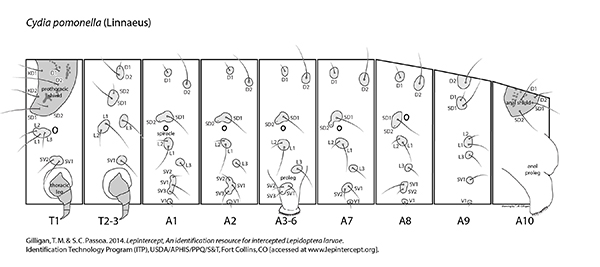 Cydia pomonella setal map Cydia pomonella setal map
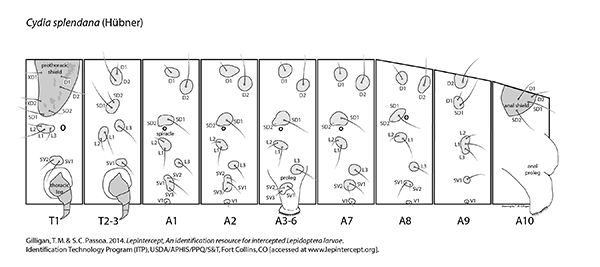 Cydia splendana setal map Cydia splendana setal map
<< Previous fact sheet Next fact sheet >>
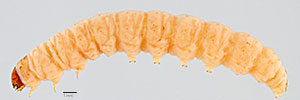 Fig. 1: Cydia pomonella, lateral view
Fig. 1: Cydia pomonella, lateral view |
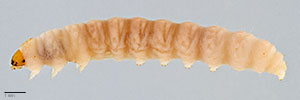 Fig. 2: Cydia splendana, lateral view
Fig. 2: Cydia splendana, lateral view |
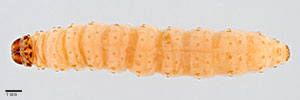 Fig. 3: Cydia pomonella, dorsal view
Fig. 3: Cydia pomonella, dorsal view |
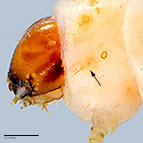 Fig. 4: Cydia pomonella, L group on T1 not extending beneath the spiracle
Fig. 4: L group on T1 |
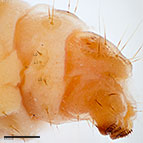 Fig. 5: Cydia pomonella, L group on A9; note lack of anal comb
Fig. 5: A9 and A10 |
 Fig. 6: Cydia pomonella, D1 and SD1 on the same pinaculum on A9
Fig. 6: D1, SD1 on A9 |
 Fig. 7: Cydia splendana, D1 and SD1 on the same pinaculum on A9
Fig. 7: D1, SD1 on A9 |
 Fig. 8: Cydia pomonella, head
Fig. 8: Head |
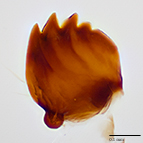 Fig. 9: Cydia splendana, mandible
Fig. 9: Mandible |
|
|
|
|
|